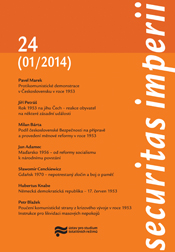Maďarsko 1956 – od reformy socialismu k národnímu povstání
Hungary in 1956 – From socialist reforms to a national uprising
Author(s): Jan AdamecSubject(s): Politics, Government/Political systems, Security and defense, Crowd Psychology: Mass phenomena and political interactions, Post-War period (1950 - 1989), History of Communism
Published by: Ústav pro studium totalitních režimů
Summary/Abstract: The study aims to analyze the crisis of the Hungarian Communist regime in 1956. It begins with the internal party struggle between Prime Minister Imre Nagy and First Secretary Matyás Rákosi in 1953–1955; this created a potentially explosive situation, with the divided and quarrelling party bodies unable to rule the country effectively and control key instruments of power, such as the press or the secret police. Nikita Khrushchev’s destalinisation initiative in 1956 triggered a new wave of conflicts between Rákosi’s supporters and those that favored more or less radical changes of the system. The demise of Rákosi and the installation of Ernő Gerő as his successor in July 1956 only encouraged dissatisfied elites within the Petofi group to criticize the party and challenge its monopoly on power. The crisis within the Communist Party was then deepened by the emotionally charged reburial of László Rajk, a former minister of the interior tried and executed during a show trial in 1949, and coincided with grave economic shortages and rising dissatisfaction in the countryside. The installation of Wladyslaw Gomulka as a member of the leadership of the Polish Communist Party at the end of October encouraged Hungarian students to organize demonstrations of support that, on 23 October 1956, grew into mass riots against the regime. New agents that then played a key role in the events in question entered the political arena. Firstly, the Soviet army intervened on behalf of the Hungarian Communist leadership; however, it failed to restore order or suppress the mass movement. Secondly, dozens of guerrilla-like insurgent groups fought enthusiastically against the Soviets. The article argues that the insurgent groups and revolutionary committees pushed a radical political agenda (national independence, multiparty system, anti-Soviet fight) and thus made it increasingly difficult, even impossible, for the newly appointed Prime Minister Nagy to reign in the conflict and negotiate a “Polish scenario” with the Kremlin. Khrushchev and his comrades contemplated postponing the use of military force for a brief period of time; however, they were then alarmed by the radicalisation of anti-Soviet sentiments within the Hungarian population and, under pressure from the Chinese Communists, opted for a massive intervention and the reinstallation of a loyal and openly pro-Soviet government and the resurrection of the already collapsed communist system. The drama of the Hungarian Uprising continued when the shattered armed groups of insurgents were replaced by trade union bodies and factory revolutionary committees in the resistance against Kádár’s newly installed regime until the end of 1956.
Journal: Securitas imperii
- Issue Year: 2014
- Issue No: 24
- Page Range: 82-122
- Page Count: 41
- Language: Czech

